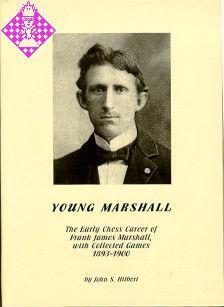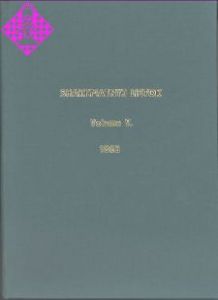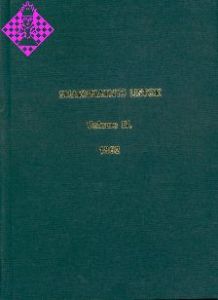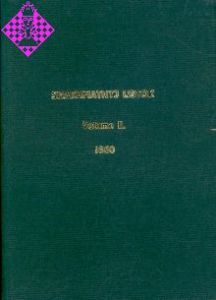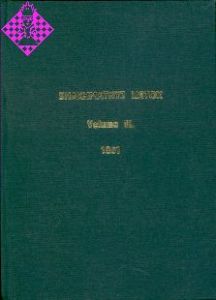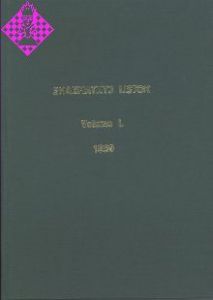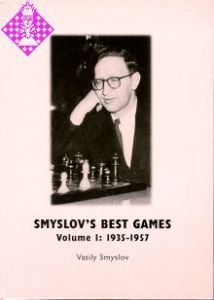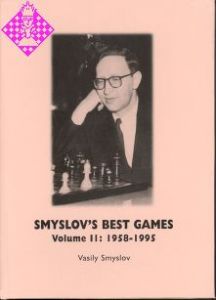When most chessplayers think of Frank James Marshall, they think of his long, twenty-seven year reign as United States Chess Champion. They think of his astounding accomplishment at Cambridge Springs 1904, where he demolished the competition, finishing with eleven wins and four draws, a Ml two points ahead of second and third place finishers Emanuel Lasker and Dawid Janowski. And perhaps they think of his reputation for Marshall "swindles," the magician grasping victory from apparent defeat.
When many chess historians think of Marshall, in truth, little more comes readily to mind regarding his long chess career. Perhaps they consider his devastating loss to Lasker in their 1907 world championship match, 0-7, with 8 draws, played in a host of United States cities, from Brooklyn to Philadelphia to Washington, DC, Chicago, Memphis and back. For those who have read Marshall's autobiographical work, My Fifty Years of Chess (or for a somewhat younger audience, raised on Dover reprints, Frank J. Marshall's Best Games of Chess} or Andy Soltis's Frank Marshall, United States Chess Champion, recollections of Marshall winning the minor tournament at London 1899 or his placing high in the crosstable at Paris 1900 might come to mind.
When serious students of Marshall think of their subject, they might recollect the future master, though born in New York, first learned the rudiments of the game in Montreal, that he quickly became one of the strongest players in Canada, that he moved to Brooklyn and won the New York State Junior title, and that he then won the championship of the Brooklyn Chess Club. But this is hardly the whole story. And in some very important ways, the story itself, by omission and outright error, is incorrect.
What rarely, if ever, comes to mind, buried as they are in the pages of long forgotten newspapers and journals, are the actual facts of Marshall's earliest years as a chessplayer, when he was learning the game from the club level on up. Both Soltis and even Marshall himself quickly gloss through his early years in chess, anxious, it seems, to get to his greatest triumphs across the chessboard. Surely there is nothing wrong with that For their purposes.
But Marshall's early career, examined in detail, offers much to casual readers as well as dedicated chess historians alike. In later years, Marshall was known for his inconsistent tournament and match performances. Yet few know that even in his earliest battles, Marshall endured a similar path of ecstatic highs and utter lows. The story of Marshall's earliest chess years is a story full of drama and, above all, struggle. Struggle in the face of setbacks. Struggle in the face of superior players. Struggle in the face of long and hard study. In short, the struggles each of us face, chessplayer and chess historian alike, in the course of our own lives, both on and off the board. Yet in Marshall's case, of course, the chess victories and the failures are writ large, almost larger than life. They are here, now, for chess readers willing to take the time to learn of them. And they are here for all who wish to be entertained through observing the mystery and mastery of chess. For both abound in the early story of Frank Marshall.
This book is the first systematic attempt to separate fact from myth in Marshall's early chess life. As the reader will learn, Marshall's own memory of his earliest days was, to say the least, suspect. Events were given in the wrong order, assigned to the wrong years, and in some cases, apparently, intentionally or not, misrepresented or ignored altogether. Soltis has told us how poor a speller and writer Marshall was. Examination of the facts of his early career suggest, too, his difficulty in grasping dates and chronology in all but the simplest terms. The true story of Marshall's earliest chess years has, simply put, never been told. Certainly not accurately. Works that have relied on Marshall's own words, even regarding such supposedly straightforward facts as the years in which he won early events, the titles he held at any given time, and the matches and tournaments he played in, have been to one degree or another misled. Whether one believes Marshall intentionally misled, or whether one believes he was as much the victim of his own faulty memory as others have been since, is a delicate question indeed. How each reader answers that question can now, at least, for the first time, be based on more than simply the myth of Marshall.
Works on Marshall typically include a dozen or so of his early games, generally the same ones, and in most instances half of those early games are from Paris 1900, Marshall's first great international success. This volume includes 173 Marshall games played between 1893 and 1900, when he was between the ages of sixteen and twenty-three. His chess career during this period is laid out in as much detail as possible. An essay on his early life accompanies the games, with internal references so interested readers can easily move between text and play. Extensive use of footnotes has been resorted to in the essay so as to satisfy both the casual reader, who can read through the text without reference to the notes to learn of Marshall's life in general, and the specialist, who is invited to explore the byways, opponents, and details brought together here in the first extensive treatment of Marshall's early career. Emphasis has been placed on those figures who loomed large in Marshall's earliest years, and so the reader will not find here detailed discussions of many of the greats of the chessboard, such as Steinitz, Pillsbury, or Lasker, although none has, obviously, been ignored. Those figures have had more than sufficient attention devoted to them elsewhere, and greater space has been reserved here, rather, for figures perhaps minor today, such as Nicolai Jasnogrodsky and Stanley Johnston, but ones who figured large in Marshall's life at the time. Little will be found here of stale and timeworn tales, unless to set the record straight. Much new, for another generation of chess enthusiasts to ponder. At least, that has been my intention.
As with any biographical study, new information will inevitably surface, and corrections will be needed. The author encourages fellow chess historians to carefully consider the materials gathered here. One point of such a work, of course, is to lay the groundwork for further study and exploration. In that sense, this book is as much a beginning as it is an end, and the author invites others to advance study and knowledge of Marshall, his games, and his times. It is hoped this volume might serve, too, as an invitation to other chess historians to continue exploring Marshall's middle and later years, so that a relatively complete picture of his achievements might someday be available for future students of the game.
As with any research project, the help received from others has made this work better than it would have been otherwise. Dr. Vlastimil Fiala, chess historian and publisher of Publishing House Moravian Chess, suggested this volume, and helped extensively in obtaining Canadian and other source material. It is to him, in large measure, readers owe the appearance of this volume at all. International Master Richard Forster very kindly annotated half a dozen of Marshall's games, ones especially significant in his career but ones that had so far escaped critical scrutiny. Larry Fyffe contributed extensive research involving Canadian chess columns, and wishes to thank Ellen Higgins of the Saint John Free Public Library for her assistance in obtaining Canadian newspaper microfilm. Edward Winter kindly allowed the reproduction of two photographs of Frank Marshall from his extensive collection. Others who have helped make this book better are Andy Ansel, Neil Brennen, J. Ken MacDonald, Eduardo Mercere, and Nick Pope. To all of them I owe my thanks, extended here. There remains but to say the author, and the author alone, is responsible for errors appearing in the text.
John S. Hilbert, Kenmore, New York, 2002
When many chess historians think of Marshall, in truth, little more comes readily to mind regarding his long chess career. Perhaps they consider his devastating loss to Lasker in their 1907 world championship match, 0-7, with 8 draws, played in a host of United States cities, from Brooklyn to Philadelphia to Washington, DC, Chicago, Memphis and back. For those who have read Marshall's autobiographical work, My Fifty Years of Chess (or for a somewhat younger audience, raised on Dover reprints, Frank J. Marshall's Best Games of Chess} or Andy Soltis's Frank Marshall, United States Chess Champion, recollections of Marshall winning the minor tournament at London 1899 or his placing high in the crosstable at Paris 1900 might come to mind.
When serious students of Marshall think of their subject, they might recollect the future master, though born in New York, first learned the rudiments of the game in Montreal, that he quickly became one of the strongest players in Canada, that he moved to Brooklyn and won the New York State Junior title, and that he then won the championship of the Brooklyn Chess Club. But this is hardly the whole story. And in some very important ways, the story itself, by omission and outright error, is incorrect.
What rarely, if ever, comes to mind, buried as they are in the pages of long forgotten newspapers and journals, are the actual facts of Marshall's earliest years as a chessplayer, when he was learning the game from the club level on up. Both Soltis and even Marshall himself quickly gloss through his early years in chess, anxious, it seems, to get to his greatest triumphs across the chessboard. Surely there is nothing wrong with that For their purposes.
But Marshall's early career, examined in detail, offers much to casual readers as well as dedicated chess historians alike. In later years, Marshall was known for his inconsistent tournament and match performances. Yet few know that even in his earliest battles, Marshall endured a similar path of ecstatic highs and utter lows. The story of Marshall's earliest chess years is a story full of drama and, above all, struggle. Struggle in the face of setbacks. Struggle in the face of superior players. Struggle in the face of long and hard study. In short, the struggles each of us face, chessplayer and chess historian alike, in the course of our own lives, both on and off the board. Yet in Marshall's case, of course, the chess victories and the failures are writ large, almost larger than life. They are here, now, for chess readers willing to take the time to learn of them. And they are here for all who wish to be entertained through observing the mystery and mastery of chess. For both abound in the early story of Frank Marshall.
This book is the first systematic attempt to separate fact from myth in Marshall's early chess life. As the reader will learn, Marshall's own memory of his earliest days was, to say the least, suspect. Events were given in the wrong order, assigned to the wrong years, and in some cases, apparently, intentionally or not, misrepresented or ignored altogether. Soltis has told us how poor a speller and writer Marshall was. Examination of the facts of his early career suggest, too, his difficulty in grasping dates and chronology in all but the simplest terms. The true story of Marshall's earliest chess years has, simply put, never been told. Certainly not accurately. Works that have relied on Marshall's own words, even regarding such supposedly straightforward facts as the years in which he won early events, the titles he held at any given time, and the matches and tournaments he played in, have been to one degree or another misled. Whether one believes Marshall intentionally misled, or whether one believes he was as much the victim of his own faulty memory as others have been since, is a delicate question indeed. How each reader answers that question can now, at least, for the first time, be based on more than simply the myth of Marshall.
Works on Marshall typically include a dozen or so of his early games, generally the same ones, and in most instances half of those early games are from Paris 1900, Marshall's first great international success. This volume includes 173 Marshall games played between 1893 and 1900, when he was between the ages of sixteen and twenty-three. His chess career during this period is laid out in as much detail as possible. An essay on his early life accompanies the games, with internal references so interested readers can easily move between text and play. Extensive use of footnotes has been resorted to in the essay so as to satisfy both the casual reader, who can read through the text without reference to the notes to learn of Marshall's life in general, and the specialist, who is invited to explore the byways, opponents, and details brought together here in the first extensive treatment of Marshall's early career. Emphasis has been placed on those figures who loomed large in Marshall's earliest years, and so the reader will not find here detailed discussions of many of the greats of the chessboard, such as Steinitz, Pillsbury, or Lasker, although none has, obviously, been ignored. Those figures have had more than sufficient attention devoted to them elsewhere, and greater space has been reserved here, rather, for figures perhaps minor today, such as Nicolai Jasnogrodsky and Stanley Johnston, but ones who figured large in Marshall's life at the time. Little will be found here of stale and timeworn tales, unless to set the record straight. Much new, for another generation of chess enthusiasts to ponder. At least, that has been my intention.
As with any biographical study, new information will inevitably surface, and corrections will be needed. The author encourages fellow chess historians to carefully consider the materials gathered here. One point of such a work, of course, is to lay the groundwork for further study and exploration. In that sense, this book is as much a beginning as it is an end, and the author invites others to advance study and knowledge of Marshall, his games, and his times. It is hoped this volume might serve, too, as an invitation to other chess historians to continue exploring Marshall's middle and later years, so that a relatively complete picture of his achievements might someday be available for future students of the game.
As with any research project, the help received from others has made this work better than it would have been otherwise. Dr. Vlastimil Fiala, chess historian and publisher of Publishing House Moravian Chess, suggested this volume, and helped extensively in obtaining Canadian and other source material. It is to him, in large measure, readers owe the appearance of this volume at all. International Master Richard Forster very kindly annotated half a dozen of Marshall's games, ones especially significant in his career but ones that had so far escaped critical scrutiny. Larry Fyffe contributed extensive research involving Canadian chess columns, and wishes to thank Ellen Higgins of the Saint John Free Public Library for her assistance in obtaining Canadian newspaper microfilm. Edward Winter kindly allowed the reproduction of two photographs of Frank Marshall from his extensive collection. Others who have helped make this book better are Andy Ansel, Neil Brennen, J. Ken MacDonald, Eduardo Mercere, and Nick Pope. To all of them I owe my thanks, extended here. There remains but to say the author, and the author alone, is responsible for errors appearing in the text.
John S. Hilbert, Kenmore, New York, 2002
When most chessplayers think of Frank James Marshall, they think of his long, twenty-seven year reign as United States Chess Champion. They think of his astounding accomplishment at Cambridge Springs 1904, where he demolished the competition, finishing with eleven wins and four draws, a Ml two points ahead of second and third place finishers Emanuel Lasker and Dawid Janowski. And perhaps they think of his reputation for Marshall "swindles," the magician grasping victory from apparent defeat.
When many chess historians think of Marshall, in truth, little more comes readily to mind regarding his long chess career. Perhaps they consider his devastating loss to Lasker in their 1907 world championship match, 0-7, with 8 draws, played in a host of United States cities, from Brooklyn to Philadelphia to Washington, DC, Chicago, Memphis and back. For those who have read Marshall's autobiographical work, My Fifty Years of Chess (or for a somewhat younger audience, raised on Dover reprints, Frank J. Marshall's Best Games of Chess} or Andy Soltis's Frank Marshall, United States Chess Champion, recollections of Marshall winning the minor tournament at London 1899 or his placing high in the crosstable at Paris 1900 might come to mind.
When serious students of Marshall think of their subject, they might recollect the future master, though born in New York, first learned the rudiments of the game in Montreal, that he quickly became one of the strongest players in Canada, that he moved to Brooklyn and won the New York State Junior title, and that he then won the championship of the Brooklyn Chess Club. But this is hardly the whole story. And in some very important ways, the story itself, by omission and outright error, is incorrect.
What rarely, if ever, comes to mind, buried as they are in the pages of long forgotten newspapers and journals, are the actual facts of Marshall's earliest years as a chessplayer, when he was learning the game from the club level on up. Both Soltis and even Marshall himself quickly gloss through his early years in chess, anxious, it seems, to get to his greatest triumphs across the chessboard. Surely there is nothing wrong with that For their purposes.
But Marshall's early career, examined in detail, offers much to casual readers as well as dedicated chess historians alike. In later years, Marshall was known for his inconsistent tournament and match performances. Yet few know that even in his earliest battles, Marshall endured a similar path of ecstatic highs and utter lows. The story of Marshall's earliest chess years is a story full of drama and, above all, struggle. Struggle in the face of setbacks. Struggle in the face of superior players. Struggle in the face of long and hard study. In short, the struggles each of us face, chessplayer and chess historian alike, in the course of our own lives, both on and off the board. Yet in Marshall's case, of course, the chess victories and the failures are writ large, almost larger than life. They are here, now, for chess readers willing to take the time to learn of them. And they are here for all who wish to be entertained through observing the mystery and mastery of chess. For both abound in the early story of Frank Marshall.
This book is the first systematic attempt to separate fact from myth in Marshall's early chess life. As the reader will learn, Marshall's own memory of his earliest days was, to say the least, suspect. Events were given in the wrong order, assigned to the wrong years, and in some cases, apparently, intentionally or not, misrepresented or ignored altogether. Soltis has told us how poor a speller and writer Marshall was. Examination of the facts of his early career suggest, too, his difficulty in grasping dates and chronology in all but the simplest terms. The true story of Marshall's earliest chess years has, simply put, never been told. Certainly not accurately. Works that have relied on Marshall's own words, even regarding such supposedly straightforward facts as the years in which he won early events, the titles he held at any given time, and the matches and tournaments he played in, have been to one degree or another misled. Whether one believes Marshall intentionally misled, or whether one believes he was as much the victim of his own faulty memory as others have been since, is a delicate question indeed. How each reader answers that question can now, at least, for the first time, be based on more than simply the myth of Marshall.
Works on Marshall typically include a dozen or so of his early games, generally the same ones, and in most instances half of those early games are from Paris 1900, Marshall's first great international success. This volume includes 173 Marshall games played between 1893 and 1900, when he was between the ages of sixteen and twenty-three. His chess career during this period is laid out in as much detail as possible. An essay on his early life accompanies the games, with internal references so interested readers can easily move between text and play. Extensive use of footnotes has been resorted to in the essay so as to satisfy both the casual reader, who can read through the text without reference to the notes to learn of Marshall's life in general, and the specialist, who is invited to explore the byways, opponents, and details brought together here in the first extensive treatment of Marshall's early career. Emphasis has been placed on those figures who loomed large in Marshall's earliest years, and so the reader will not find here detailed discussions of many of the greats of the chessboard, such as Steinitz, Pillsbury, or Lasker, although none has, obviously, been ignored. Those figures have had more than sufficient attention devoted to them elsewhere, and greater space has been reserved here, rather, for figures perhaps minor today, such as Nicolai Jasnogrodsky and Stanley Johnston, but ones who figured large in Marshall's life at the time. Little will be found here of stale and timeworn tales, unless to set the record straight. Much new, for another generation of chess enthusiasts to ponder. At least, that has been my intention.
As with any biographical study, new information will inevitably surface, and corrections will be needed. The author encourages fellow chess historians to carefully consider the materials gathered here. One point of such a work, of course, is to lay the groundwork for further study and exploration. In that sense, this book is as much a beginning as it is an end, and the author invites others to advance study and knowledge of Marshall, his games, and his times. It is hoped this volume might serve, too, as an invitation to other chess historians to continue exploring Marshall's middle and later years, so that a relatively complete picture of his achievements might someday be available for future students of the game.
As with any research project, the help received from others has made this work better than it would have been otherwise. Dr. Vlastimil Fiala, chess historian and publisher of Publishing House Moravian Chess, suggested this volume, and helped extensively in obtaining Canadian and other source material. It is to him, in large measure, readers owe the appearance of this volume at all. International Master Richard Forster very kindly annotated half a dozen of Marshall's games, ones especially significant in his career but ones that had so far escaped critical scrutiny. Larry Fyffe contributed extensive research involving Canadian chess columns, and wishes to thank Ellen Higgins of the Saint John Free Public Library for her assistance in obtaining Canadian newspaper microfilm. Edward Winter kindly allowed the reproduction of two photographs of Frank Marshall from his extensive collection. Others who have helped make this book better are Andy Ansel, Neil Brennen, J. Ken MacDonald, Eduardo Mercere, and Nick Pope. To all of them I owe my thanks, extended here. There remains but to say the author, and the author alone, is responsible for errors appearing in the text.
John S. Hilbert, Kenmore, New York, 2002
When many chess historians think of Marshall, in truth, little more comes readily to mind regarding his long chess career. Perhaps they consider his devastating loss to Lasker in their 1907 world championship match, 0-7, with 8 draws, played in a host of United States cities, from Brooklyn to Philadelphia to Washington, DC, Chicago, Memphis and back. For those who have read Marshall's autobiographical work, My Fifty Years of Chess (or for a somewhat younger audience, raised on Dover reprints, Frank J. Marshall's Best Games of Chess} or Andy Soltis's Frank Marshall, United States Chess Champion, recollections of Marshall winning the minor tournament at London 1899 or his placing high in the crosstable at Paris 1900 might come to mind.
When serious students of Marshall think of their subject, they might recollect the future master, though born in New York, first learned the rudiments of the game in Montreal, that he quickly became one of the strongest players in Canada, that he moved to Brooklyn and won the New York State Junior title, and that he then won the championship of the Brooklyn Chess Club. But this is hardly the whole story. And in some very important ways, the story itself, by omission and outright error, is incorrect.
What rarely, if ever, comes to mind, buried as they are in the pages of long forgotten newspapers and journals, are the actual facts of Marshall's earliest years as a chessplayer, when he was learning the game from the club level on up. Both Soltis and even Marshall himself quickly gloss through his early years in chess, anxious, it seems, to get to his greatest triumphs across the chessboard. Surely there is nothing wrong with that For their purposes.
But Marshall's early career, examined in detail, offers much to casual readers as well as dedicated chess historians alike. In later years, Marshall was known for his inconsistent tournament and match performances. Yet few know that even in his earliest battles, Marshall endured a similar path of ecstatic highs and utter lows. The story of Marshall's earliest chess years is a story full of drama and, above all, struggle. Struggle in the face of setbacks. Struggle in the face of superior players. Struggle in the face of long and hard study. In short, the struggles each of us face, chessplayer and chess historian alike, in the course of our own lives, both on and off the board. Yet in Marshall's case, of course, the chess victories and the failures are writ large, almost larger than life. They are here, now, for chess readers willing to take the time to learn of them. And they are here for all who wish to be entertained through observing the mystery and mastery of chess. For both abound in the early story of Frank Marshall.
This book is the first systematic attempt to separate fact from myth in Marshall's early chess life. As the reader will learn, Marshall's own memory of his earliest days was, to say the least, suspect. Events were given in the wrong order, assigned to the wrong years, and in some cases, apparently, intentionally or not, misrepresented or ignored altogether. Soltis has told us how poor a speller and writer Marshall was. Examination of the facts of his early career suggest, too, his difficulty in grasping dates and chronology in all but the simplest terms. The true story of Marshall's earliest chess years has, simply put, never been told. Certainly not accurately. Works that have relied on Marshall's own words, even regarding such supposedly straightforward facts as the years in which he won early events, the titles he held at any given time, and the matches and tournaments he played in, have been to one degree or another misled. Whether one believes Marshall intentionally misled, or whether one believes he was as much the victim of his own faulty memory as others have been since, is a delicate question indeed. How each reader answers that question can now, at least, for the first time, be based on more than simply the myth of Marshall.
Works on Marshall typically include a dozen or so of his early games, generally the same ones, and in most instances half of those early games are from Paris 1900, Marshall's first great international success. This volume includes 173 Marshall games played between 1893 and 1900, when he was between the ages of sixteen and twenty-three. His chess career during this period is laid out in as much detail as possible. An essay on his early life accompanies the games, with internal references so interested readers can easily move between text and play. Extensive use of footnotes has been resorted to in the essay so as to satisfy both the casual reader, who can read through the text without reference to the notes to learn of Marshall's life in general, and the specialist, who is invited to explore the byways, opponents, and details brought together here in the first extensive treatment of Marshall's early career. Emphasis has been placed on those figures who loomed large in Marshall's earliest years, and so the reader will not find here detailed discussions of many of the greats of the chessboard, such as Steinitz, Pillsbury, or Lasker, although none has, obviously, been ignored. Those figures have had more than sufficient attention devoted to them elsewhere, and greater space has been reserved here, rather, for figures perhaps minor today, such as Nicolai Jasnogrodsky and Stanley Johnston, but ones who figured large in Marshall's life at the time. Little will be found here of stale and timeworn tales, unless to set the record straight. Much new, for another generation of chess enthusiasts to ponder. At least, that has been my intention.
As with any biographical study, new information will inevitably surface, and corrections will be needed. The author encourages fellow chess historians to carefully consider the materials gathered here. One point of such a work, of course, is to lay the groundwork for further study and exploration. In that sense, this book is as much a beginning as it is an end, and the author invites others to advance study and knowledge of Marshall, his games, and his times. It is hoped this volume might serve, too, as an invitation to other chess historians to continue exploring Marshall's middle and later years, so that a relatively complete picture of his achievements might someday be available for future students of the game.
As with any research project, the help received from others has made this work better than it would have been otherwise. Dr. Vlastimil Fiala, chess historian and publisher of Publishing House Moravian Chess, suggested this volume, and helped extensively in obtaining Canadian and other source material. It is to him, in large measure, readers owe the appearance of this volume at all. International Master Richard Forster very kindly annotated half a dozen of Marshall's games, ones especially significant in his career but ones that had so far escaped critical scrutiny. Larry Fyffe contributed extensive research involving Canadian chess columns, and wishes to thank Ellen Higgins of the Saint John Free Public Library for her assistance in obtaining Canadian newspaper microfilm. Edward Winter kindly allowed the reproduction of two photographs of Frank Marshall from his extensive collection. Others who have helped make this book better are Andy Ansel, Neil Brennen, J. Ken MacDonald, Eduardo Mercere, and Nick Pope. To all of them I owe my thanks, extended here. There remains but to say the author, and the author alone, is responsible for errors appearing in the text.
John S. Hilbert, Kenmore, New York, 2002
| Weight | 510 g |
|---|---|
| Manufacturer | Caissa 90-Olomouc |
| Width | 15 cm |
| Height | 21 cm |
| Medium | Book |
| Year of Publication | 2002 |
| Author | John S. Hilbert |
| Language | English |
| ISBN-10 | 8071894389 |
| ISBN-13 | 978-80-7189-438-4 |
| Pages | 282 |
| Binding | hardback |
i Introduction
iv Table of Contents
001 PART 1: Frank James Marshall, The Early Years
122 PART 2: Marshall's Chess Games 1893-1900
264 Crosstables
271 Tournament and Match Record, 1893-1900
275 Marshall Game Index
277 General Index
iv Table of Contents
001 PART 1: Frank James Marshall, The Early Years
122 PART 2: Marshall's Chess Games 1893-1900
264 Crosstables
271 Tournament and Match Record, 1893-1900
275 Marshall Game Index
277 General Index
Marshall betrat die Bühne des internationalen Schachs mit dem berühmten Turnier Paris 1900. Er schlug dort gleich Lasker und Pillsbury und erreichte den geteilten dritten Rang. Dieses Turnier wird ausführlich beschrieben, bildet aber auch das Ende des vorliegenden Buches. Der Schwerpunkt der Biographie liegt auf den Anfängen der großen Karriere Marshalls.
Schachmarkt 04/2003
Den Buchumschlag schmückt das Foto eines jungen Mannes, den man eher als erfolglosen Revolverhelden in einem Experimentalwestern von Jim Jarmusch erwarten würde als an einem Schachbrett. Auch der Titel führt einen zunächst auf eine falsche Spur. „Young Marshall" ist da zu lesen, was wiederum eher an einen Hilfssheriff von Dodge-City denken lässt als an das königliche Spiel. Schließlich verrät nach solch subtilen Irritationen der Untertitel, dass es im vorliegenden Werk um die frühe Schachkarriere des amerikanischen Meisters Frank James Marshall geht. Der Autor John S. Hilbert hat sich der Jahre 1893-1900 angenommen, die aus dem kanadischen Schachteenager den geachteten internationalen Turnierspieler des großen Pariser Turniers von 1900 werden ließen. Marshall gehörte danach für Jahrzehnte zu den festen Größen im jungen amerikanischen Schach. Dass dieser Erfolg ihm nicht in den Schoß gefallen ist, sondern Frucht langen Lernens und unermüdlicher Schachpraxis war, zeigt die „Schachbiographie" im ersten Teil des Buches. Der zweite Teil illustriert diesen Werdegang durch 173 mehr oder (meist) weniger kommentierte Partien.
Wer nun hofft, etwas über den Menschen Marshall in Erfahrung zu bringen, wird hier nicht fündig. Vor dem Hintergrund einiger weniger dürrer Daten, wie die Geburt am 10. 8. 1877 in New York, den Umzug der Familie nach Montreal 1885 und die Rückkehr 1895 in die USA, nach Brooklyn, ist der schachliche Werdegang in epischer Breite entwickelt. Der Leser wird mit so ziemlich jedem Turnier, jedem Vereins- , ja sogar mit jedem Vereinslokalwechsel, behelligt. Wie Marshalls schachliche Leitbilder ausgesehen haben könnten, bleibt im Dunkeln. Learning by doing scheint das Rezept zur Spielstärkesteigerung gewesen sein. So kommt Marshall selbst mit der Empfehlung zu Wort, der schnellste Weg zur spielerischen Verbesserung sei die unverzügliche Mitgliedschaft in einem Schachclub. Den DSB wird's freuen!
Überhaupt entwickelt der Autor auf den 121 Seiten des biographischen Teils eine kaum gezügelte Begeisterung fürs Zitieren. Neben zahllosen Zeitungsartikeln war auch das Buch My Fifty Years of Chess von Frank Marshall selbst ein unerschöpfliches Reservoir recyclingfähigen Materials. An mehreren Punkten allerdings kann John S. Hilbert Marshall nachweisen, dass er in seiner Autobiographie nicht immer mit sich selbst deckungsgleich ist. Es scheint durchaus verzeihlich, wenn sich ein Meister nach einem langen Schachleben nicht mehr hundertprozentig daran erinnern kann, wann er Vereinsmeister des Brooklyner Schachclubs war oder wann er an einer Blindsimultanveranstaltung gegen eine lokale Größe teilnahm. Schließlich hatte Marshall für seine eigene Biographie nicht die wertvollen Informationen aus 312 Fußnoten zur Verfügung. Allein sie machen annähernd ein Drittel des Textes aus! Was an Marshalls Werdegang den nachhaltigsten Eindruck hinterlässt, ist der unermüdliche Ehrgeiz, durch dauerndes Spielen gegen möglichst stärkere Gegner, sich selbst weiter zu entwickeln. Er war nämlich durchaus kein Wunderkind und hatte daher, besonders nach großen Erfolgen wie den Turnieren in London (1899) und Paris (1900), herbe Rückschläge in miserabel gespielten Begegnungen zu verkraften. So folgte nach seinem hervorragenden Abschneiden im Kreise der Weltelite beim Pariser Turnier ein letzter Platz mit 2,5:7,5 bei der „Vereinsmeisterschaft" im Manhattan Chess Club!
Auch diese Katastrophen stehen im Partieteil des Buches. Meist spärlich kommentiert taucht man in die Welt des Schachs der Jahrhundertwende ein. Allerlei Romantisches bietet sich dem Auge dar, mit Fleiß wird hier noch geopfert, und wenn „gestorben" wird, dann aber richtig. Die Qualität der Partien ist folglich sehr schwankend, aber das Nachspielen auf jeden Fall unterhaltsam, zumal man endlich mal wieder ein flottes Königsgambit zu sehen bekommt oder die beliebte Einsteigereröffnung Italienisch. Die Notation ist fehlerfrei, die Diagramme schnell erfassbar. Ein wenig problematisch ist mitunter die Abschnittseinteilung. Nicht immer wird deutlich, ob es sich um den „Abspann" der Vorgängerpartie handelt oder ob es bereits Teil der neuen Partie ist. Daran krankt vor allem auch der biographische Teil, der abgesehen von vielen Absätzen weder durch Kapiteleinteilung noch sonstige Strukturierungsversuche verformt ist. Wenn man dann neben schacharchäologischen Raritäten wie der ältesten bekannten, in diesem Falle rekonstruierten, Partie Marshalls auch so erheiternde Kurzpartien wie die gegen die lokale Schachgröße Short genießen darf, kommt man durchaus auf seine Kosten. Für Liebhaber des Sujets sicher eine Fundgrube.
Zeitschrift KARL 04/2004
Frank James Marshall (1877-1944) gilt als einer der führenden Schachmeister in der Geschichte der USA und kann wohl in einem Atemzuge genannt werden mit anderen legendären Gestalten der dortigen Schachszene wie Paul Morphy, Harry Nelson Pillsbury, Reuben Fine und Robert James Fischer. In seiner langen Schachlaufbahn hielt Marshall 27 Jahre den Titel des US-Champions und wurde gerühmt ob seines furchtlosen Angriffsspiels und gelegentlicher „Schwindeleien", mit deren Hilfe er schon verloren geglaubte Partien noch aus dem Feuer riss. John S. Hilbert, ein New-Yorker Schachhistoriker, hat nach ausführlichen Recherchen ein Buch für Marshall-Fans herausgebracht, worin er die ersten, wechselvollen Jahre der Karriere des künftigen Großmeisters bis zum Jahre 1900 nachzeichnet. Der erste Teil des Buches (S. 1-121) ist der Schilderung der schachlichen Jugend Marshalls gewidmet: Geboren in New York, erlernte er das Schachspielen mit acht Jahren von seinem Vater, schloss sich aber erst 1892 dem Schachklub in Montreal an, wo seine Familie zwischenzeitlich lebte. 1895 nach New York zurückgekehrt, trat er dem Brooklyner Schachklub bei, etwa zeitgleich mit dem hoch begabten William Ewart Napier. Diesem drei Jahre jüngeren Konkurrenten unterlag Marshall in einem Wettkampf mit 1:7 bei drei Remisen; er ließ sich durch diesen herben Rückschlag allerdings nicht beeindrucken und gewann das Brooklyner Vereinsturnier 1898 nach einem 2:1-Stichkampfsieg gegen eben jenen Napier. Der Jung-Profi Marshall beteiligte sich mit durchaus gemischten Resultaten an diversen weiteren lokalen Turnieren und Zweikämpfen (wobei es gegen den Altmeister S. Lipschütz gleich zweimal - 1898 und 1899 - 0:3-Schlappen setzte).
1899 betrat Marshall die internationale Schach-Bühne durch einen Sieg beim B-Turnier des Londoner Schachkongresses mit 8,5/11, einen halben Zähler vor dem renommierten Wiener Georg Marco.
Der endgültige Durchbruch gelang dann beim Pariser Meisterturnier 1900, wo Marshall hinter dem Weltmeister Emanuel Lasker und seinem Landsmann Harry N. Pillsbury einen sensationellen dritten Platz belegte (12,0/16). Mit dem frischen Lorbeer nach Hause zurückgekehrt, stellte sich gleich wieder ein Rückschlag ein in Gestalt eines letzten Platzes beim doppelrundigen Sechs-Meister-Turnier von New York 1900 (Sieger Lipschütz).
Führt der Autor im ersten Teil bereits 20 Partien/Partiefragmente von Zeitgenossen Marshalls in den ausgiebigen Fußnoten zum Haupttext an, so präsentiert er im zweiten Abschnitt (S. 122-263) insgesamt 173 Marshall-Partien von 1893 bis 1900, darunter alle seine Kämpfe in London 1899 und Paris 1900, zusätzlich angereichert mit 24 Porträt-Fotos bzw. -Zeichnungen damaliger Schachgrößen.
Beim ersten Zusammentreffen mit dem amtierenden Weltmeister gelang Marshall gleich ein Erfolg gegen den späteren souveränen Turniersieger. Im Anhang (S. 264-274) finden sich sieben Kreuztabellen sowie eine Auflistung von 19 Turnieren und zwölf Wettkämpfen mit Beteiligung Marshalls aus dem Zeitraum 1893 bis 1900. Das liebevoll zusammengestellte Werk dürfte wohl in erster Linie Liebhaber der Schach-Historie interessieren, welche allerdings des Englischen mächtig sein sollten.
Dr. W. Schweizer, Rochade Europa 02/2004
Schachmarkt 04/2003
Den Buchumschlag schmückt das Foto eines jungen Mannes, den man eher als erfolglosen Revolverhelden in einem Experimentalwestern von Jim Jarmusch erwarten würde als an einem Schachbrett. Auch der Titel führt einen zunächst auf eine falsche Spur. „Young Marshall" ist da zu lesen, was wiederum eher an einen Hilfssheriff von Dodge-City denken lässt als an das königliche Spiel. Schließlich verrät nach solch subtilen Irritationen der Untertitel, dass es im vorliegenden Werk um die frühe Schachkarriere des amerikanischen Meisters Frank James Marshall geht. Der Autor John S. Hilbert hat sich der Jahre 1893-1900 angenommen, die aus dem kanadischen Schachteenager den geachteten internationalen Turnierspieler des großen Pariser Turniers von 1900 werden ließen. Marshall gehörte danach für Jahrzehnte zu den festen Größen im jungen amerikanischen Schach. Dass dieser Erfolg ihm nicht in den Schoß gefallen ist, sondern Frucht langen Lernens und unermüdlicher Schachpraxis war, zeigt die „Schachbiographie" im ersten Teil des Buches. Der zweite Teil illustriert diesen Werdegang durch 173 mehr oder (meist) weniger kommentierte Partien.
Wer nun hofft, etwas über den Menschen Marshall in Erfahrung zu bringen, wird hier nicht fündig. Vor dem Hintergrund einiger weniger dürrer Daten, wie die Geburt am 10. 8. 1877 in New York, den Umzug der Familie nach Montreal 1885 und die Rückkehr 1895 in die USA, nach Brooklyn, ist der schachliche Werdegang in epischer Breite entwickelt. Der Leser wird mit so ziemlich jedem Turnier, jedem Vereins- , ja sogar mit jedem Vereinslokalwechsel, behelligt. Wie Marshalls schachliche Leitbilder ausgesehen haben könnten, bleibt im Dunkeln. Learning by doing scheint das Rezept zur Spielstärkesteigerung gewesen sein. So kommt Marshall selbst mit der Empfehlung zu Wort, der schnellste Weg zur spielerischen Verbesserung sei die unverzügliche Mitgliedschaft in einem Schachclub. Den DSB wird's freuen!
Überhaupt entwickelt der Autor auf den 121 Seiten des biographischen Teils eine kaum gezügelte Begeisterung fürs Zitieren. Neben zahllosen Zeitungsartikeln war auch das Buch My Fifty Years of Chess von Frank Marshall selbst ein unerschöpfliches Reservoir recyclingfähigen Materials. An mehreren Punkten allerdings kann John S. Hilbert Marshall nachweisen, dass er in seiner Autobiographie nicht immer mit sich selbst deckungsgleich ist. Es scheint durchaus verzeihlich, wenn sich ein Meister nach einem langen Schachleben nicht mehr hundertprozentig daran erinnern kann, wann er Vereinsmeister des Brooklyner Schachclubs war oder wann er an einer Blindsimultanveranstaltung gegen eine lokale Größe teilnahm. Schließlich hatte Marshall für seine eigene Biographie nicht die wertvollen Informationen aus 312 Fußnoten zur Verfügung. Allein sie machen annähernd ein Drittel des Textes aus! Was an Marshalls Werdegang den nachhaltigsten Eindruck hinterlässt, ist der unermüdliche Ehrgeiz, durch dauerndes Spielen gegen möglichst stärkere Gegner, sich selbst weiter zu entwickeln. Er war nämlich durchaus kein Wunderkind und hatte daher, besonders nach großen Erfolgen wie den Turnieren in London (1899) und Paris (1900), herbe Rückschläge in miserabel gespielten Begegnungen zu verkraften. So folgte nach seinem hervorragenden Abschneiden im Kreise der Weltelite beim Pariser Turnier ein letzter Platz mit 2,5:7,5 bei der „Vereinsmeisterschaft" im Manhattan Chess Club!
Auch diese Katastrophen stehen im Partieteil des Buches. Meist spärlich kommentiert taucht man in die Welt des Schachs der Jahrhundertwende ein. Allerlei Romantisches bietet sich dem Auge dar, mit Fleiß wird hier noch geopfert, und wenn „gestorben" wird, dann aber richtig. Die Qualität der Partien ist folglich sehr schwankend, aber das Nachspielen auf jeden Fall unterhaltsam, zumal man endlich mal wieder ein flottes Königsgambit zu sehen bekommt oder die beliebte Einsteigereröffnung Italienisch. Die Notation ist fehlerfrei, die Diagramme schnell erfassbar. Ein wenig problematisch ist mitunter die Abschnittseinteilung. Nicht immer wird deutlich, ob es sich um den „Abspann" der Vorgängerpartie handelt oder ob es bereits Teil der neuen Partie ist. Daran krankt vor allem auch der biographische Teil, der abgesehen von vielen Absätzen weder durch Kapiteleinteilung noch sonstige Strukturierungsversuche verformt ist. Wenn man dann neben schacharchäologischen Raritäten wie der ältesten bekannten, in diesem Falle rekonstruierten, Partie Marshalls auch so erheiternde Kurzpartien wie die gegen die lokale Schachgröße Short genießen darf, kommt man durchaus auf seine Kosten. Für Liebhaber des Sujets sicher eine Fundgrube.
Zeitschrift KARL 04/2004
Frank James Marshall (1877-1944) gilt als einer der führenden Schachmeister in der Geschichte der USA und kann wohl in einem Atemzuge genannt werden mit anderen legendären Gestalten der dortigen Schachszene wie Paul Morphy, Harry Nelson Pillsbury, Reuben Fine und Robert James Fischer. In seiner langen Schachlaufbahn hielt Marshall 27 Jahre den Titel des US-Champions und wurde gerühmt ob seines furchtlosen Angriffsspiels und gelegentlicher „Schwindeleien", mit deren Hilfe er schon verloren geglaubte Partien noch aus dem Feuer riss. John S. Hilbert, ein New-Yorker Schachhistoriker, hat nach ausführlichen Recherchen ein Buch für Marshall-Fans herausgebracht, worin er die ersten, wechselvollen Jahre der Karriere des künftigen Großmeisters bis zum Jahre 1900 nachzeichnet. Der erste Teil des Buches (S. 1-121) ist der Schilderung der schachlichen Jugend Marshalls gewidmet: Geboren in New York, erlernte er das Schachspielen mit acht Jahren von seinem Vater, schloss sich aber erst 1892 dem Schachklub in Montreal an, wo seine Familie zwischenzeitlich lebte. 1895 nach New York zurückgekehrt, trat er dem Brooklyner Schachklub bei, etwa zeitgleich mit dem hoch begabten William Ewart Napier. Diesem drei Jahre jüngeren Konkurrenten unterlag Marshall in einem Wettkampf mit 1:7 bei drei Remisen; er ließ sich durch diesen herben Rückschlag allerdings nicht beeindrucken und gewann das Brooklyner Vereinsturnier 1898 nach einem 2:1-Stichkampfsieg gegen eben jenen Napier. Der Jung-Profi Marshall beteiligte sich mit durchaus gemischten Resultaten an diversen weiteren lokalen Turnieren und Zweikämpfen (wobei es gegen den Altmeister S. Lipschütz gleich zweimal - 1898 und 1899 - 0:3-Schlappen setzte).
1899 betrat Marshall die internationale Schach-Bühne durch einen Sieg beim B-Turnier des Londoner Schachkongresses mit 8,5/11, einen halben Zähler vor dem renommierten Wiener Georg Marco.
Der endgültige Durchbruch gelang dann beim Pariser Meisterturnier 1900, wo Marshall hinter dem Weltmeister Emanuel Lasker und seinem Landsmann Harry N. Pillsbury einen sensationellen dritten Platz belegte (12,0/16). Mit dem frischen Lorbeer nach Hause zurückgekehrt, stellte sich gleich wieder ein Rückschlag ein in Gestalt eines letzten Platzes beim doppelrundigen Sechs-Meister-Turnier von New York 1900 (Sieger Lipschütz).
Führt der Autor im ersten Teil bereits 20 Partien/Partiefragmente von Zeitgenossen Marshalls in den ausgiebigen Fußnoten zum Haupttext an, so präsentiert er im zweiten Abschnitt (S. 122-263) insgesamt 173 Marshall-Partien von 1893 bis 1900, darunter alle seine Kämpfe in London 1899 und Paris 1900, zusätzlich angereichert mit 24 Porträt-Fotos bzw. -Zeichnungen damaliger Schachgrößen.
Beim ersten Zusammentreffen mit dem amtierenden Weltmeister gelang Marshall gleich ein Erfolg gegen den späteren souveränen Turniersieger. Im Anhang (S. 264-274) finden sich sieben Kreuztabellen sowie eine Auflistung von 19 Turnieren und zwölf Wettkämpfen mit Beteiligung Marshalls aus dem Zeitraum 1893 bis 1900. Das liebevoll zusammengestellte Werk dürfte wohl in erster Linie Liebhaber der Schach-Historie interessieren, welche allerdings des Englischen mächtig sein sollten.
Dr. W. Schweizer, Rochade Europa 02/2004
More from Caissa 90-Olomouc

